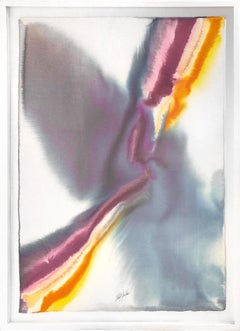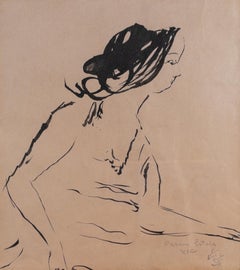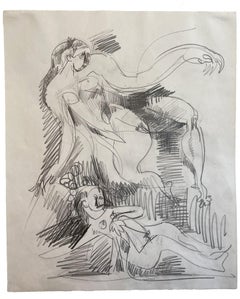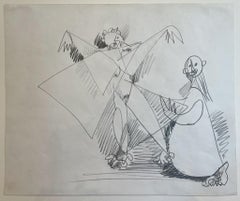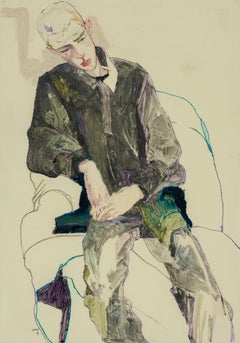Rafael Gallery Drawings and Watercolor Paintings
to
18
16
1
14
4
13
2
1
1
1
Overall Height
to
Overall Width
to
5
1
1
14
11
7
5
4
3
3
2
2
2
1
1
1
1
1
1
1
1
1
1
18
1
4
4
2
1
1
8
7
6
6
2
Stripes
By Paul Jenkins
Located in New York, NY
Stripes by Paul Jenkins (1923-2012)
Watercolor on paper
42 x 30 ¼ inches unframed (106.68 x 76.835 cm)
47 ½ x 35 ½ inches framed (120.65 x 90.17 cm)
Inscribed (Jenkins) on bottom cen...
Category
Late 20th Century Abstract Expressionist Abstract Drawings and Watercolors
Materials
Watercolor
Seated Woman
By Jules Pascin
Located in New York, NY
Seated Woman by Jules Pascin (1885-1930)
Pen and ink on paper
6 ½ x 6 inches unframed (16.51 x 15.24 cm)
14 x 13 inches framed (35.56 x 33.02 cm)
Inscribed (Pascin Estate 81C) on bot...
Category
Early 20th Century Expressionist Figurative Drawings and Watercolors
Materials
Ink
Study for Sculpture of Nude Woman Balancing Baby
By Chaim Gross
Located in New York, NY
Study for Sculpture of Nude Woman Balancing Baby, 1949, by Chaim Gross (1902-1991)
Ink on paper
10 ½ x 7 ½ inches unframed (26.67 x 19.05 cm)
1...
Category
1940s Modern Figurative Drawings and Watercolors
Materials
Paper, Ink, Pen
Figure Looking Out Window
By Jules Pascin
Located in New York, NY
Figure Looking Out Window by Jules Pascin (1885-1930)
Watercolor on paper
5 ¼ x 4 ½ inches unframed (13.335 x 11.43 cm)
13 ¾ x 10 ⅜ inches framed (34.925 x 27.002 cm)
Signed and date...
Category
20th Century Figurative Drawings and Watercolors
Materials
Watercolor
Figure and Female Nude
By Hans Hofmann
Located in New York, NY
Figure and Female Nude, ca. 1925, by Hans Hofmann (1880-1966)
Pencil on paper
17 x 14 inches unframed (43.18 x 35.56 cm)
Description:
This figurative drawing by German-American arti...
Category
Early 20th Century Figurative Drawings and Watercolors
Materials
Paper, Pencil
Crucifixion
By Hans Hofmann
Located in New York, NY
Crucifixion, ca. 1925, by Hans Hofmann (1880-1966)
Pencil on paper
17 x 14 inches unframed (43.18 x 35.56 cm)
Description:
This figure drawing by Hans Hofmann provides a unique look...
Category
Early 20th Century Post-Modern Figurative Drawings and Watercolors
Materials
Pencil
Moses With the Ten Commandments
By Sir Jacob Epstein
Located in New York, NY
Moses With the Ten Commandments by Sir Jacob Epstein (1880-1959)
Pencil and watercolor on paper
22 x 16 ⅝ inches unframed (55.88 x 42.24 cm)
28 ½ x 23 inches framed (72.39 x 58.42 cm)
Signed on bottom left
Description:
In this figurative watercolor painting, Jacob Epstein depicts Moses holding two tablets, one in each arm, that are inscribed with the ten commandments. This is a visualization of the traditional biblical story in which Moses goes to Mount Sinai and has the ten commandments revealed to him by God which he inscribed onto two tablets and keeps in the Ark of the Covenant...
Category
20th Century Post-Modern Figurative Drawings and Watercolors
Materials
Watercolor, Pencil
Woman With Red Poppies
By Philip Boileau
Located in New York, NY
Woman With Red Poppies, 1905, by Philip Boileau (1863-1917)
Pastel on paper
35 ½ × 22 ¾ inches unframed (90.17 x 57.785 cm)
Signed, dated, and inscribed...
Category
Early 20th Century Art Nouveau Portrait Drawings and Watercolors
Materials
Pastel
New Mexican Mountain Scene
By Joseph Henry Sharp
Located in New York, NY
New Mexico Mountain Scene by Joseph Henry Sharp (1859-1953)
Watercolor on paper
15 ¾ x 19 ½ inches unframed (40.005 x 49.53 cm)
23 x 26 ¾ inches framed...
Category
20th Century Post-Modern Landscape Drawings and Watercolors
Materials
Watercolor
Recto: "Cubist City Scene" Verso: "Pineapple Still Life"
By Jan Matulka
Located in New York, NY
Recto: ‘Cubist City Scene’ Verso: ‘Pineapple Still Life’ by Jan Matulka (1890-1972)
Pencil, colored pencil, and watercolor on paper
14 ¼ x 27 ½ inches unfr...
Category
20th Century Modern Landscape Drawings and Watercolors
Materials
Watercolor, Pencil
Seated Feminine Figure
By Reuven Rubin
Located in New York, NY
Seated Feminine Figure by Reuven Rubin (1893-1974)
Pencil on paper
7 ½ x 7 ¾ inches unframed (19.05 x 19.685 cm)
14 x 14 inches framed (35.56 x 35.56 ...
Category
20th Century Figurative Drawings and Watercolors
Materials
Pencil
Two Seated Men
By Henri Lebasque
Located in New York, NY
“Two Seated Men” by Henri Lebasque (1865-1937)
Pencil and watercolor on paper
6 x 5 inches unframed (15.24 x 12.7 cm)
Signed on bottom right
Description:
In ...
Category
20th Century Figurative Drawings and Watercolors
Materials
Watercolor, Pencil
Contemplative Man
By Jules Pascin
Located in New York, NY
Contemplative Man by Jules Pascin (1885-1930)
Ink on paper
6 ¾ x 4 ⅝ inches unframed (17.145 x 11.7602 cm)
11 x 14 inches framed (27.94 x 35.56 cm)
Signed on top right
Description:...
Category
20th Century Portrait Drawings and Watercolors
Materials
Ink
Cuban Women
By Jules Pascin
Located in New York, NY
Cuban Women by Jules Pascin (1885-1930)
Pencil on paper
6 ¾ x 2 ⅞ inches unframed (17.145 x 7.3152 cm)
14 ¼ x 10 ½ inches framed (36.195 x 26.67 cm)
Estate stamp on middle left
Des...
Category
20th Century Post-Modern Figurative Drawings and Watercolors
Materials
Pencil
Padua near Venice
By Max Weber
Located in New York, NY
Equestrian Statue by Donatello- Padua near Venice, 1907, by Max Weber (1881-1961)
Ink wash and blue chalk on paper
4 x 5 inches unframed (10.16 x 12.7 cm)
10 ¾ x 12 ⅞ inches framed...
Category
Early 20th Century Post-Modern Figurative Drawings and Watercolors
Materials
Chalk, Ink
Portrait or Study for a Bust
By Chaim Gross
Located in New York, NY
Portrait or Study for a Bust, 1959 by Chaim Gross (1902-1991)
Ink wash and pencil on paper
8 x 5 inches unframed (20.32 x 12.7 cm)
14 ⅛ x 11 inches framed (35.8775 x 27.94 cm)
Signed...
Category
Mid-20th Century Modern Portrait Drawings and Watercolors
Materials
Ink, Pencil
Figural Study
By Chaim Gross
Located in New York, NY
Figural Study, ca. 1949-1959, by Chaim Gross (1902-1991)
Ink on fabric
18 x 16 ¼ inches (45.72 x 41.275 cm)
25 x 23 ⅝ inches (63.5 x 60.0075 cm)
Inscribed...
Category
Mid-20th Century Modern Figurative Drawings and Watercolors
Materials
Ink
Happy Birthday
By Chaim Gross
Located in New York, NY
Happy Birthday, 1950, by Chaim Gross (1902-1991)
Ink on paper
5 ¼ x 4 inches unframed (13.335 x 10.16 cm)
11 ¼ x 10 ⅛ inches framed (28.575 x 25.7175 cm...
Category
Mid-20th Century Modern Figurative Drawings and Watercolors
Materials
Ink
Related Items
The Abduction of the Sabine Women , a Renaissance drawing by Biagio Pupini
Located in PARIS, FR
This vigorous drawing has long been attributed to Polidoro da Caravaggio: The Abduction of the Sabine Women is one of the scenes that Polidoro depicted between 1525 and 1527 on the façade of the Milesi Palazzo in Rome. However, the proximity to another drawing inspired by this same façade, kept at the Ecole des Beaux-Arts, and to other drawings inspired by Polidoro kept at the Musée du Louvre, leads us to propose an attribution to Biagio Pupini, a Bolognese artist whose life remains barely known, despite the abundant number of drawings attributed to him.
1. Biagio Pupini, a Bolognese artist in the light of the Roman Renaissance
The early life of Biagio Pupini, an important figure of the first half of the Cinquecento in Bologna - Vasari mentions him several times - is still poorly known. Neither his date of birth (probably around 1490-1495) nor his training are known. He is said to have been a pupil of Francesco Francia (1450 - 1517) and his name appears for the first time in 1511 in a contract with the painter Bagnacavallo (c. 1484 - 1542) for the frescoes of a church in Faenza. He then collaborated with Girolamo da Carpi, at San Michele in Bosco and at the villa of Belriguardo.
He must have gone to Rome for the first time with Bagnacavallo between 1511 and 1519. There he discovered the art of Raphael, with whom he might have worked, and that of Polidoro da Caravaggio. This first visit, and those that followed, were the occasion for an intense study of ancient and modern art, as illustrated by his abundant graphic production.
Polidoro da Caravaggio had a particular influence on the technique adopted by Pupini. Executed on coloured paper, his drawings generally combine pen, brown ink and wash with abundant highlights of white gouache, as in the drawing presented here.
2. The Abduction of the Sabine Women
Our drawing is an adaptation of a fresco painted between 1525 and 1527 by Polidoro da Caravaggio on the façade of the Milesi Palace in Rome. These painted façades were very famous from the moment they were painted and inspired many artists during their stay in Rome. These frescoes are now very deteriorated and difficult to see, as the palace is in a rather narrow street.
The episode of the abduction of the Sabine women (which appears in the centre of the photo above) is a historical theme that goes back to the origins of Rome and is recounted both by Titus Livius (Ab Urbe condita I,13), by Ovid (Fasti III, 199-228) and by Plutarch (II, Romulus 14-19). After killing his twin brother Romus, Romulus populates the city of Rome by opening it up to refugees and brigands and finds himself with an excess of men. Because of their reputation, none of the inhabitants of the neighbouring cities want to give them their daughters in marriage. The Romans then decide to invite their Sabine neighbours to a great feast during which they slaughter the Sabines and kidnap their daughters.
The engraving made by Giovanni Battista Gallestruzzi (1618 - 1677) around 1656-1658 gives us a good understanding of the Polidoro fresco, allowing us to see how Biagio Pupini reworked the scene to extract this dynamic group.
With a remarkable economy of means, Biagio Pupini takes over the left-hand side of the fresco and depicts in a very dense space two main groups, each consisting of a Roman and a Sabine, completed by a group of three soldiers in the background (which seems to differ quite significantly from Polidoro's composition).
The balance of the drawing is based on a very strongly structured composition. The drawing is organised around a median vertical axis, which runs along both the elbow of the kidnapped Sabine on the left and the foot of her captor, and the two main diagonals, reinforced by four secondary diagonals. This diamond-shaped structure creates an extremely dynamic space, in which centripetal movements (the legs of the Sabine on the right, the arm of the soldier on the back at the top right) and centrifugal movements (the arm of the kidnapper on the left and the legs of the Sabine he is carrying away, the arm of the Sabine on the right) oppose each other, giving the drawing the appearance of a whirlpool around a central point of support situated slightly to the left of the navel of the kidnapper on the right.
3. Polidoro da Caravaggio, and the decorations of Roman palaces
Polidoro da Caravaggio was a paradoxical artist who entered Raphael's (1483 - 1520) workshop at a very young age, when he oversaw the Lodges in the Vatican. Most of his Roman work, which was the peak of his career, has disappeared, as he specialised in facade painting, and yet these paintings, which are eminently visible in urban spaces, have influenced generations of artists who copied them abundantly during their visits to Rome.
Polidoro Caldara was born in Caravaggio around 1495-1500 (the birthplace of Michelangelo Merisi, known as Caravaggio, who was born there in 1571), some forty kilometres east of Milan. According to Vasari, he arrived as a mason on the Vatican's construction site and joined Raphael's workshop around 1517 (at the age of eighteen according to Vasari). This integration would have allowed Polidoro to work not only on the frescoes of the Lodges, but also on some of the frescoes of the Chambers, as well as on the flat of Cardinal Bibiena in the Vatican.
After Raphael's death in 1520, Polidoro worked first with Perin del Vaga before joining forces with Maturino of Florence (1490 - 1528), whom he had also known in Raphael's workshop. Together they specialised in the painting of palace façades. They were to produce some forty façades decorated with grisaille paintings imitating antique bas-reliefs.
The Sack of Rome in 1527, during which his friend Maturino was killed, led Polidoro to flee first to Naples (where he had already stayed in 1523), then to Messina. It was while he was preparing his return to the peninsula that he was murdered by one of his assistants, Tonno Calabrese, in 1543.
In his Vite, Vasari celebrated Polidoro as the greatest façade decorator of his time, noting that "there is no flat, palace, garden or villa in Rome that does not contain a work by Polidoro". Polidoro's facade decorations, most of which have disappeared as they were displayed in the open air, constitute the most important lost chapter of Roman art of the Cinquecento. The few surviving drawings of the painter can, however, give an idea of the original appearance of his murals and show that he was an artist of remarkable and highly original genius.
4. The façade of the Milesi Palace
Giovanni Antonio Milesi, who commissioned this palace, located not far from the Tiber, north of Piazza Navona, was a native of the Bergamo area, like Polidoro, with whom he maintained close friendly ties. Executed in the last years before the Sack of Rome, around 1526-1527, the decoration of Palazzo Milesi is considered Polidoro's greatest decorative success.
An engraving by Ernesto Maccari made at the end of the nineteenth century allows us to understand the general balance of this façade, which was still well preserved at the time. The frescoes were not entirely monochrome, but alternated elements in chiaroscuro simulating marble bas-reliefs and those in ochre simulating bronze and gold vases...
Category
16th Century Old Masters Figurative Drawings and Watercolors
Materials
Ink, Gouache, Pen
Lee Hurst (3/4 Figure, Hands Together), Mixed media on Pergamenata parchment
By Howard Tangye
Located in London, GB
Howard Tangye (b.1948, Australia) has been an influential force in fashion for decades. Lecturing at London’s Central Saint Martins for 35 years, including 16 years as head of BA Wom...
Category
2010s Contemporary Portrait Paintings
Materials
Paint, Paper, Parchment Paper, Charcoal, Crayon, Oil Crayon, Oil Pastel,...
François-Édouard Picot (French 1786-1868) Greek Comedy Play 19th Century Drawing
By François-Édouard Picot
Located in Meinisberg, CH
François-Édouard Picot
(French, 1786 – 1868)
Ancient Greek Comedy Play
• Pencil Drawing on laid paper behind decorative matting, visible image, ca. 10.5 x 15.5 cm
• Modern Glased frame, ca. 27 x 33 cm
• Signed "Picot fecit" lower left
• As we photographed through glass, there are reflections in the images
Worldwide shipping is complimentary - There are no charges for handling & delivery
Here we have the somewhat unusual, yet typical subject matter François-Édouard Picot was interested in depicting. Shown is a scene from an ancient Greek comedy play. The previous owner has noted on the back, that this image was copied from an ancient Greek stone relief.
François-Édouard Picot was born on the 10th of October in 1786 in Paris, France. He studied with various masters and became well known for his historical and mythological subjects. In 1812 he won the second prize in the Prix de Rome competition and after that success, went on to exhibit at the Paris Salon, where in the year 1819 he won a first-class medal for his neoclassical L'Amour et Psyché, which today hangs in the Louvre in Paris. He regularly exhibited his work in the salon up to 1839. He taught several young great artists at his elitist studio and was known for accepting only very few students, which included William Bouguereau, Gustave Moreau, Cabanel and Paul Seignac...
Category
Early 19th Century Naturalistic Figurative Drawings and Watercolors
Materials
Laid Paper, Pencil
Free Shipping
H 10.63 in W 13 in D 1.19 in
“Arc de Triomphe, Paris”
By André Vignoles
Located in Southampton, NY
Original oil pastel with graphite tracing of a lively Paris street scene in front of the iconic Arc de Triomphe in Paris. The artist is the well known French artist, Andre Vignoles. ...
Category
1960s Post-Modern Figurative Drawings and Watercolors
Materials
Oil Pastel, Archival Paper, Graphite
Freya (Seated Backwards), Mixed media on grey board
By Howard Tangye
Located in London, GB
Howard Tangye (b.1948, Australia) has been an influential force in fashion for decades. Lecturing at London’s Central Saint Martins for 35 years, including 16 years as head of BA Wom...
Category
2010s Contemporary Figurative Paintings
Materials
Other Medium, Archival Paper, Handmade Paper, Pen, Felt Pen, Permanent M...
Gustav Melcher ( German, 1898 -?) Boats off Venice Italy Ink Water Color c. 1918
By Gustav Melcher
Located in Meinisberg, CH
Gustav Melcher
(German, 1898-?)
Segelschiffe vor Venedig - Sailing ships off Venice
• India ink, water colour wash
• Visible image ca. 11.5 x 18 cm
• Glased Frame ca. 20 x 25 cm
• Verso various inscriptions
• Signed lower right
Gustav Melcher was a German painter and a pioneer in film, film criticism and film theory and created this clever little picture of the skyline of Venice with various vessels.
Going by the various inscriptions an the backing paper, this drawing was made in 1918 when Gustav was twenty years old and passed on three years later to Gertrud Melcher on the 1. 2. 1921. I have no reasons to doubt this information. The small drawing is still in its unopened frame, so maybe there is more information to be discovered , however this will be the privilege of the next owner.
The picture also has retained its original antique frame – note that it has lost over the years various sections of the gesso decoration.
The very precisely executed drawing is most enjoyable to look at and doing so, remember you are looking through the eyes of a young man, who saw this foreign sea cape over a century ago.
Thank you for your interest and please note, that I offer free worldwide shipping on all my items.
Gustav Melcher began his studies at the Düsseldorfer Kunstakademie under Peter Janssen and Eduard von Gebhardt. Originaly he was interested in figurative and portrait painting, but after time he decided to pursue the depiction of land- and marinescapes. Durin his studies the young artist undertook trips to visit England, Scotland, Belgium and France and he joined the artist society Malkasten. It was in those days he would hold speeches to his colleges about this new invention called ‘Kintopp’ – Melcher was a great advocate of the moving pictures...
Category
1910s Naturalistic Landscape Drawings and Watercolors
Materials
India Ink, Paper, Watercolor
Gustav MelcherGustav Melcher ( German, 1898 -?) Boats off Venice Italy Ink Water Color c. 1918, 1918
Free Shipping
H 7.88 in W 9.85 in D 0.79 in
20th century French school, Colonnade in ruins, watercolor
Located in Paris, FR
20th century French school
Colonnade in ruins,
watercolor on paper
37 x 26 cm
Framed in a highly original way between two sheets of Plexiglas (a small, barely visible spot on the bl...
Category
1960s Post-Modern Interior Drawings and Watercolors
Materials
Watercolor
Abstract Watercolor Painting, 'Design for Space', 2003 by David Ruth
By David Ruth
Located in Oakland, CA
This is a contemporary abstract watercolor painting by artist David Ruth. This series of paintings often feature bright colors and vibrant layouts that draw the viewer in. They are c...
Category
Early 2000s Abstract Expressionist Abstract Paintings
Materials
Paper, Watercolor
Expressionist Color Drawing Cobalt Glass Vintage Frame Modernist Ben Zion WPA
By Ben-Zion Weinman
Located in Surfside, FL
Expressionist ink and pastel crayon drawing of flowers in vase.
Framed in a vintage cobalt blue glass original frame
Hand signed and dated
Framed it measures 13.5 X 10.5
The actual paper is 7.5 X 5.5
Born in 1897, Ben-Zion Weinman celebrated his European Jewish heritage in his visual works as a sculptor, painter, and printmaker. Influenced by Spinoza, Knut Hamsun, and Wladyslaw Reymont, as well as Hebrew literature, Ben-Zion wrote poetry and essays that, like his visual work, attempt to reveal the deep “connection between man and the divine, and between man and earth.” An emigrant from the Ukraine, he came to the US in 1920. He wrote fairy tales and poems in Hebrew under the name Benzion Weinman, but when he began painting he dropped his last name and hyphenated his first, saying an artist needed only one name.
Ben-Zion was a founding member of “The Ten: An Independent Group” The Ten” a 1930’s avant-garde group, Painted on anything handy. Ben-Zion often used cabinet doors (panels) in his work. Other members of group included Ilya Bolotowsky, Lee Gatch, Adolph Gottlieb, Louis Harris, Yankel Kufeld, Marcus Rothkowitz (later known as Mark Rothko), Louis Schanker, and Joseph Solman. The Art of “The Ten” was generally described as expressionist, as this style offered the best link between modernism and social art. Their exhibition at the Mercury Gallery in New York held at the same time as the Whitney Annual Exhibition of Contemporary American Painting, included a manifesto concentrating on aesthetic questions and criticisms of the conservative definition of modern art imposed by the Whitney. Ben-Zion’s work was quickly noticed. The New York Sun said he painted “furiously” and called him “the farthest along of the lot.” And the triptych, “The Glory of War,” was described by Art News as “resounding.”
By 1939, The Ten disbanded because most of the members found individual galleries to represent their work. Ben-Zion had his first one-man show at the Artist’s Gallery in Greenwich Village and J.B. Neumann, the highly esteemed European art dealer who introduced Paul Klee, (among others) to America, purchased several of Ben-Zion’s drawings. Curt Valentin, another well-known dealer, exhibited groups of his drawings and undertook the printing of four portfolios of etchings, each composed of Ben-Zion’s biblical themes. He worked as a WPA artist.
Ben-Zion’s work is represented in many museums throughout the country including the Metropolitan, the Whitney, and the Museum of Modern Art in New York, the Art Institute of Chicago, the Philadelphia Museum of Art and the Phillips Collection, Washington. The Jewish Museum in New York opened in 1948 with a Ben-Zion exhibition.
Ben-Zion consistently threaded certain subject matter—nature, still life, the human figure, the Hebrew Bible, and the Jewish people—into his work throughout his life. "In all his work a profound human feeling remains. Sea and sky, even sheaves of wheat acquire a monolithic beauty and simplicity which delineates the transient as a reflection of the eternal. This sensitive inter- mingling of the physical and metaphysical is one of the most enduring features of Ben-Zion's works." (Excerpt from Stephen Kayser, “Biblical Paintings,” The Jewish Museum Catalogue, 1952). Mystical Imprints: Marc Chagall, Ben-Zion, and Ben Shahn presents the print work of three prominent 20th century Jewish artists born in the Russian Empire. Among these seventy pieces are etchings and lithographs from Chagall’s Bible series...
Category
1950s Expressionist Still-life Drawings and Watercolors
Materials
Paper, Oil Crayon, Pastel, Ink
Gawkers, Original Illustration by Bill Ward
Located in Long Island City, NY
Artist: Bill Ward, American (1919 - 1998)
Title: Gawkers
Year: circa 1981
Medium: Graphite and Watercolor on Paper, signed l.r.
Size: 23 in. x 17 in. (58.42 ...
Category
1980s Post-Modern Figurative Drawings and Watercolors
Materials
Graphite
"Flower Stand S.F. 1954" - Vintage Illustration
By Irene Pattinson
Located in Soquel, CA
"Flower Stand S.F. 1954" - Vintage Illustration
This detailed ink drawing by Irene Pattinson (American, 1909-1999), shows a charming San Francisc...
Category
1950s American Modern Figurative Drawings and Watercolors
Materials
Paper, India Ink, Pen
Cats Watching a Witch on a Broomstick - Vintage Halloween Illustration in Ink
By Irene Pattinson
Located in Soquel, CA
Cats Watching a Witch on a Broomstick - Vintage Halloween Illustration in Ink
Halloween scene with cats and a witch in India ink pen by Irene Pattinson (American, 1909-1999). A blac...
Category
1950s American Modern Figurative Drawings and Watercolors
Materials
Paper, Watercolor, Pen, India Ink
H 18 in W 20 in D 0.25 in
